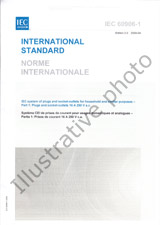We need your consent to use the individual data so that you can see information about your interests, among other things. Click "OK" to give your consent.

IEC/TR 62547-ed.2.0
Guidelines for the measurement of high-power damage sensitivity of single-mode fibre to bends - Guidance for interpretation of results
STANDARD published on 16.5.2013
The information about the standard:
Designation standards: IEC/TR 62547-ed.2.0
Publication date standards: 16.5.2013
SKU: NS-407908
The number of pages: 40
Approximate weight : 120 g (0.26 lbs)
Country: International technical standard
Category: Technical standards IEC
The category - similar standards:
Annotation of standard text IEC/TR 62547-ed.2.0 :
IEC/TR 62547:2013(E) describes two methods for the measurement of the sensitivity of single-mode optical fibres to high-power damage at bends: - test method 1 - Failure time characterisation as a function of the launch power and bend conditions (bend angle and bend diameter); - test method 2 - Equilibrium temperature measurement. Results from the two methods can only be compared qualitatively. This second edition cancels and replaces the first edition published in 2009, and constitutes a technical revision. The main changes with respect to the previous edition are: - updates related to B6 (bend-insensitive) category single-mode fibres); - update to analysis for test method 2: Maximum temperature specification. Key words: sensitivity of single-mode optical fibres to high-power damage at bends


 Cookies
Cookies
